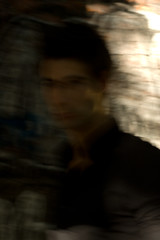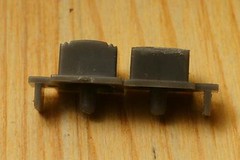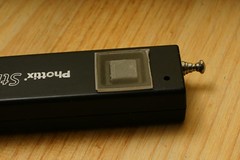Model Mayhem: Alex Marks
In this example taken at a recent strobist meetup, the flash didn't fire in the first exposure, which gives me the opportunity to show you what's happening. You can see in the unlit example that the majority of the image is very dark and the wall behind the model's head is well lit by sunlight. As I took the picture I moved the camera sideways to create some streaking of the image. You'll need to make sure that your sunlit portion of the image has some texture, in this case its a brick wall with graffiti, otherwise you won' get streaks. The shutter speed is 1/20s at f10 and ISO400
The flash is an Nikon SB28 in a softbox very close to the models head at about 1/4 power. I have also positioned it so that it casts a shadow over his face preventing the direct sunlight from contributing to the exposure. Its angled so that very little light hits the wall and what light does fall on the wall is very much reduced in power because the wall is much further from the light source than the subject.
The direction that the camera is moved is important because you don't want the flashlit area to merge with the bright ambient in this instance I'm moving the camera from left to right with rear curtain sync. Trying to figure out which direction to move the camera does my head in, so I just try both directions and then pick the one that works. Even though the shutter speed is 1/20s the flash fires for less than 1/1000s, superimposing a pin sharp image of his face on the dark area of the picture and the sunlit portion of the image gives him go-faster stripes.






